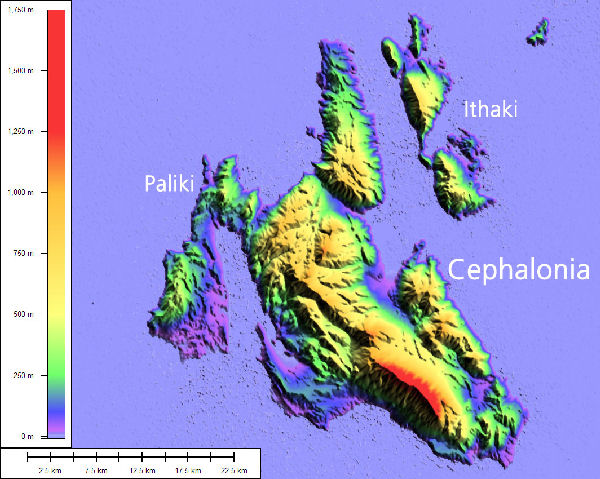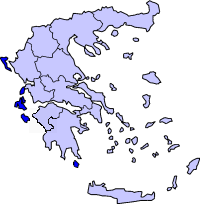
 | |
Map of Paliki (now) & surroundings: Homer said his Ithaca was "to the west, the furthest out to sea", and "low-lying"... (click the image to enlarge) |
"Where was Homer's 'Ithaca'?" -- The central character of Homer's epic, the Odyssey long was thought to have been fictional: Odysseus, and Achilles and Agamemnon and Hector and the many other "heroes" of that epic, and of Homer's other epic his Iliad, all were thought by many to be simply the products of a poet's imagination -- not real people, or even based upon real people -- and the stories and locations described in the epics were thought to be imaginary as well. Yet there were many "local" claims, that some Homeric hero long ago had inhabited this or that contemporary region or village, and there were the extremely detailed geographic descriptions in the epic itself: both invited investigation of the enticing possibility that Homer's heroes might have been real, and at least that the location of the sites described in the epics might be found.
Then came Heinrich Schliemann, who tracked down several of the more famous "myths & legends" surrounding these heroes: many locations around the Mediterraneanwere claimed to have been the heroes' "homes", such as the ruins at Mycenae, and the little hill in western Turkey now known as Hissarlik, at 39|57|27.94|N,26|14|19.30|E (Wikimapia), (Google Earth) -- Schliemann's work and excavations proposed, to a very sceptical world, that Homer's Agamemnon had lived at Mycenae, and that Troy itself indeed had existed at Hissarlik. Much work has been done to identify other Homeric sites, as well: the palace of Nestor at Pylos, at 37|01|39.00|N,21|41|41.00|E, (Wikimapia), (Google Earth), for example, has been the subject of much scholarly research, archaeological work, and controversy.
 | |
Where was Homer's "Ithaca"? |
There have been many suggestions as to where, exactly, the "Ithaca" described in great detail in Homer's Odyssey, the home of Odysseus, might have been located: as many, perhaps, as the theories which once fought among themselves over whether Troy ever really existed, and if so where it was. Theories on the location of "Homer's 'Ithaca'" were formulated as early as the 2d c. BC to as recently as AD 2003.
Each approach to identifying a location has been different, varying in degrees of scientific procedure, empirical investigation, informed hypothesis, wishful thinking, fervent belief, and sheer fantasy. Each investigator and each investigation merits interest, as an indicator both of the temper of the times in which a particular theory was developed, and of the perennial interest in Homer's Odyssey, and his character Odysseus, and the possible facts of the latter's life, or at least of a life like his might have been. The processes of theory-building and scientific inquiry change: interestingly, some of the latest "Homer's 'Ithaca'" approaches most resemble some of the earliest. But some other things -- such as interest in epics, and in their heroes -- remain the same, over time.
Leading Precursors : theorists, and their theories, on the location of "Homer's 'Ithaca'" --
 | |
Eratosthenes |
 | |
Strabo |
A correspondent writes: (on The WELL, see europe.ind.59.915, 922)
"There are various interpretations as to the origin the name Ithaca; it is believed that it comes from:
"The name Ithaca has remained unchanged since ancient times but it has been noticed that in written documents of different periods it was referred to other names such as:
"I had never heard for example of 'Ithacos, the hero' though I see he's described as a son of Poseidon elsewhere. One problem I suspect is the different dialects the name passed through in ancient times: northwest Greek and Dorian to the Ithaca natives, Ionian to the first transcriber of the written Odyssey, and whatever dialect Homer spoke."
 | |
Dörpfeld |
"The location of Homeric Ithaca always has been a subject of controversy, some finding it on modern-day Ithaki, others on Cephalonia, still others anywhere else...
"The author here is in the second group: his argument rests in the first place on the description given by Homer of Ithaca in the Odyssey 9.21-26 : according to these verses, Ithaca is found πανυπερτατη, lying low, προς ξοφον and the other islands Doulichion (modern Ithaki), Samos (ancient name of Cephalonia) and Zakynthos towards the dawn and the sun προς ηω τ ηελιον τε. Homeric Ithaca therefore cannot be modern Ithaki: instead Ithaca was, according to this author, the modern Paliki peninsula separated from Cephalonia by the gulf of Argostoli and the isthmus of Ayia Kiriaki.
[Samuel Butler renders Homer's Odyssey 9.12-26 Ithaca description: "I live in Ithaca, where there is a high mountain called Neritum, covered with forests; and not far from it there is a group of islands very near to one another - Dulichium, Same, and the wooded island of Zacynthus. It lies squat on the horizon, all highest up in the sea towards the sunset, while the others lie away from it towards dawn." http://www.perseus.tufts.edu/cgi-bin/ptext?doc=Perseus%3Atext%3A1999.01.0218&query=book%3D%239. JK]
"The second point discussed is the term νησος, 'island' : the author shows that in the Homeric era that could have signified a peninsula, as in the name for the Peloponnesus, πελοποννεσος; in the same way the term αμφιαλος, the name for Ithaca, does not signify that it is surrounded by the sea (which Homer describes using the term περιρρυτος, the name for Crete) but simply that Ithaca had the sea on two sides.
"Having located Ithaca on the modern peninsula of Paliki, the author tries to find the different specific sites identified there by Homer, by considering their relationships to one another, the distances which separate them, their names, their archaeological evidence. Thus ancient Pale, of which there are archaeological signs, 1000 meters north of Lixouri, was the capital and the site of the Palace of Odysseus. The farm of Eumaeos was in the surroundings of the village of Chavdata, three hours' walk from the palace, the time taken by Eumaeos to arrive per Odyssey 14 ; in a place named Karabostasi, a putting-in place for boats north of Pale, he finds the remains of an ancient port today covered with eroded soil and sediment, and, at Vigglanas (from vigilo, Latin for "I see, I survey", in Greek βιγλιζω, βιγλα, some hills near Lixouri, the Hill of Hermes from which Eumaeos saw in detail the return of a ship to port (Odyssey 16).
"Some locations remain a mystery, such as the 'Grotto of the Nymphs' or even the 'Palace of Odysseus' ; but the concern of the author, as it is of all who attempt this, is to have the Homeric text agree with the geographic realities ; in reality, 'modern-day Ithaki is not Homeric Ithaca precisely because, if one accepts this identification, the Homeric text which we have cited no longer makes sense' (G. Volterras)."
And some other ideas: theories about the location of Odyssean wanderings have includedc --
(caveat: the links which follow tend to go inactive more than most, and then they pop up again -- every attempt will be made to keep them current, but if they're temporarily dead the entry still is retained, to show the great variety of "Ithaca" locations which have been proposed)
(Footnotes)
--oOo--
From here you can,
Jump back to the top of this page ,
or,
Jump to the Paliki, Homer's "Ithaca" home page,
or,
please send any suggestion: any & all suggestions for improvements, additions, deletions,
or anything else well-intended,
will be gratefully appreciated
-- on parle français, l'español, l'anglais, l'américain... --
via email to kessler@well.com
Merci!
(Apologies and thanks to Sergey Ayukov.)
--oOo--
And, want to see these pages in rough-but-serviceable French? Click =>
http://www.google.com/language_tools
and enter "http://www.well.com/~kessler/paliki.html"... & bonne chance... "Nous sommes tryin' juste notre meilleur, ici..."
(More apologies and a big merci infiniement,
this time to Emmanuelle Richard.)
--oOo--
The legal stuff:
And re. permissions: This file has been updated and expanded since versions of two articles which I wrote originally on Wikipedia: and I was sole author of those, until March 12, 2006 anyway. So I am not certain what copyright or license permissions are necessary, or can be claimed against me by Wikipedia or anyone else, for the March 12 contents of the original two articles there, as that now appears here -- content which people there, particularly one official "Administrator", later altered, abridged, otherwise changed, re-focussed, re-named, etc., and I think finally may have obliterated entirely (I lost track) -- or certainly for the substantially altered & expanded & otherwise much-changed webpage(s) which appear here. But just in case they do, the Wikipedia license statements which I understand they feel are necessary appear below, and the Wikipedia code / HTML of the versions there as written by me and last seen there by me on March 12, and used here, appear here in the following files: paliki0312.html, hithaca0312.html. If folks at Wikipedia wish to discuss any of this with me I wish they would do so, per their brave statement, "Wikipedia is not a democracy, we seek consensus through discussion", at http://en.wikipedia.org/wiki/WP:NOT: which they do not do in practice, in my experience -- not the "discussion" part of it, anyway -- their "Administrators" just wade in arbitrarily, and change things, or even take them over entirely and run them however they personally and arbitrarily wish, and then let authors try to fight them about it post facto. So here I am sort of giving up on writing this "for" Wikipedia, and instead am writing it "with" Wikipedia... which may be a Good Thing, ultimately, for all concerned, and actually one of the best "next-step" developments of the overall Wikipedia effort, now that I think about it...
Copyright (c)2006- , by Jack Kessler, kessler@well.com.
Permission is granted to copy, distribute and/or modify this document
under the terms of the GNU Free Documentation License, Version 1.2
or any later version published by the Free Software Foundation;
with no Invariant Sections, no Front-Cover Texts, and no Back-Cover Texts.
A copy of the license is included in the section entitled "GNU Free Documentation License".
And for anything else here not covered, legally, by the above license
-- and you'll have to ask your own "experienced copyright practitioner" lawyer, about that --
please see the following:
Copyright © 2006- by Jack Kessler, all rights reserved.
(It's easy to get my permission to copy and distribute the things I write,
if you need it: just ask me -- email address appears below -- generally I
have no objection, so long as my name and email address appear,
but only if I'm asked in advance.)
W3 site maintained at http://www.well.com/~kessler/paliki.html
Document maintained by: Jack Kessler, kessler@well.com
Last update: July 1, 2008